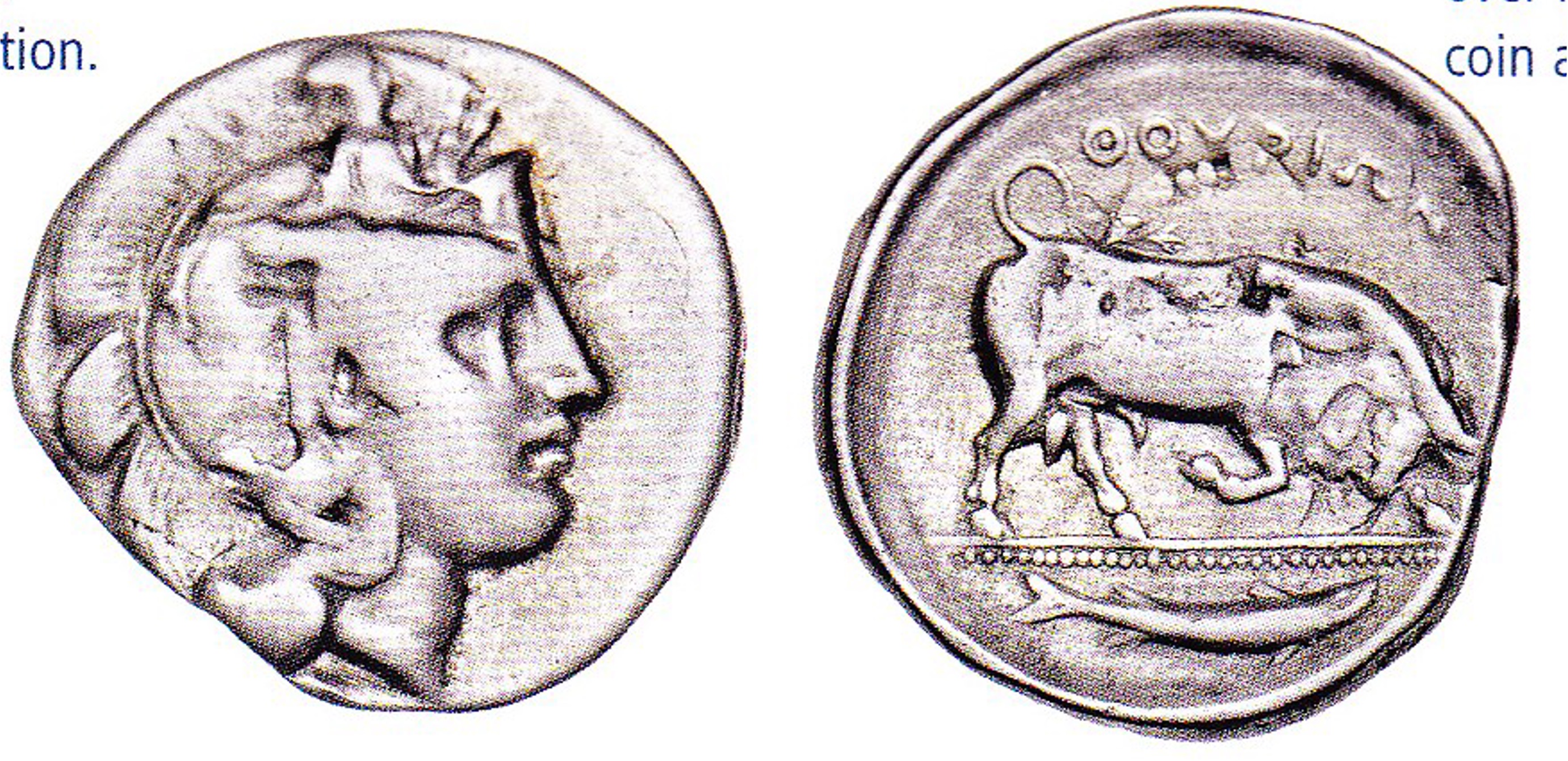400 BCE - 350 BCE | ΘΟΥΡΙΩΝ
Overstriking coin
SO 1309 - Thurium over Dyrrhachium.jpg
Overstruck variety
Dyrrhachium_Delta.jpg
[1]
Description
| ObverseInscription or printing placed on the obverse.:
|
Head of Athena right, wearing crested Attic helmet decorated with Skylla.
|
ReverseInscription or printing placed on the reverse.:
|
ΘΟΥΡΙΩΝ (Greek) Bull charging right. In exergue, fish right.
|
Mint and issuing power
| MintIdentifies the place of manufacture or issue of a numismatic object.:
|
Thurium
|
Ancient regionAncient region.
|
Lucania
|
Modern countryModern country: Italy
|
AuthorityIdentifies the issuing power. The authority can be "pretended" when the name or the portrait of X is on the coin but he/she was not the issuing power. It can also be "uncertain" when there is no mention of X on the coin but he/she was the issuing power according to the historical sources:
|
|
Chronology
| FromIdentifies the initial date in a range assigned in a numismatic context. 400 BCE toIdentifies the final date in a range assigned in a numismatic context.. 350 BCE
|
Classical 480-323 BC  periodTime period of the numismatic object. periodTime period of the numismatic object.
|
Physical description
MetalThe physical material (usually metal) from which an object is made.: Silver 
|
WeightWeight of the numismatic object (in grams). in grams: 7.417.41 g <br />7,410 mg <br />
|
DenominationTerm indicating the value of a numismatic object. Examples: tetradrachm, chalkous, denarius.: nomos
|
AxisDescribes the directional relationship between the obverse and reverse of a numismatic object.: 11 mm <br />0.1 cm <br />
|
|
|
StandardStandard.: Achaian
|
References
| Coin referenceReference of the Coin:
|
MacDonald 2009, p. 31-32, n° 22
|
Coin series referenceReference to coin series study:
|
MacDonald 20091MacDonald 2009, p. 31-32, n° 22, HN Italy2HN Italy, n° 1794c-1795, 1820, 1828-1831, 1836, 1843, 1862, 1870, 1872 (Skylla on helmet on obverse/fish on reverse: 1794d?), HGC 13HGC 1, n° 1260 or 1262
|
Description
| ObverseInscription or printing placed on the obverse.:
|
Pegasus flying right (visible on obverse: foreleg and portion of Pegasus's belly).
|
ReverseInscription or printing placed on the reverse.:
|
Head of Aphrodite right, wearing Corinthian helmet. Behind, Δ and club (visible on reverse: helmet from nose downwards, profile of Aphrodite to throat, portion of neck guard, back of helmet and Δ).
|
Mint and issuing power
| MintIdentifies the place of manufacture or issue of a numismatic object. ᵖ:
|
Dyrrhachium
|
Ancient regionAncient region. ᵖ
|
Illyricum
|
Modern countryModern country: Albania
|
AuthorityIdentifies the authority in whose name (explicitly or implicitly) a numismatic object was issued. ᵖ:
|
|
Chronology
| FromIdentifies the initial date in a range assigned in a numismatic context. 365 BCE toIdentifies the final date in a range assigned in a numismatic context.. 350 BCE
|
Classical 480-323 BC  periodTime period of the numismatic object. periodTime period of the numismatic object.
|
Physical description
| DenominationTerm indicating the value of a numismatic object. Examples: tetradrachm, chalkous, denarius. ᵖ:
|
stater 
|
|
|
References
References
- ^ Macdonald, David (2009), Overstruck Greek coins: studies in Greek chronology and monetary theory, Whitman Publishing, Atlanta.
- ^ Rutter N. Keith et alii (eds.) (2001), Historia Numorum Italy, London, xvi, 223 p., 43 pl.
- ^ Hoover, Oliver D. (2018), The Handbook of Greek Coinage Series, Volume 1. Handbook of Coins of Italy and Magna Graecia, Sixth to First Centuries BC., Lancaster-London, 2018, lxi, 527 pages, 23 cm
- ^ Meta, Albana (2015), Le monnayage en argent de Dyrrachion. 375-60/55 av. J.-C., Athens, 405 p.


